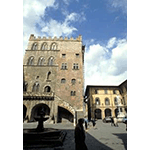Museo Civico di Prato [Prato Civic Museum]
The Civic Museum, which has been located since 1912 in the medieval Palazzo Pretorio, constitutes the city's oldest cultural institution for history and collections. Promoted by Grand Duke Peter Leopold of Lorraine as early as 1788, with the intention of creating a "school of taste" for future artists, it was inaugurated in 1858 in the nearby Palazzo Comunale.
The Museum displays a number of masterpieces from the 14th century, Renaissance paintings, seventeenth-eighteenth century works, nineteenth-century drawings, Della Robbia sculptural works, sculptures by the Prato artist Lorenzo Bartolini and objects from the production of the minor arts (eighteenth-century ceramics, weapons from the Risorgimento period, Gonfaloniers' costumes).
Although the Museum has a predominantly historical artistic orientation, it is also quite interesting from the historical scientific viewpoint, due to the presence of the collection coming from the pharmacy of the Misericordia e Dolce Hospital.
According to some historians, among them Pedrazzini and Fracassini, the pharmacy must have been in existence already in the 13th century. In 1545 it was re-established as a pharmaceutical laboratory. After having ceased to operate toward the end of the 19th century, it was rebuilt in 1933 in a fourteenth-century hall in Prato's Palazzo Pretorio, at the initiative of the pharmacist Tommaso Fracassini. The furnishings consist of a wooden cabinet painted light blue, decorated with lozenge motifs and trimmed in white. The pharmaceutical collection is composed of numerous decorated majolica jars of various shapes, some of them produced by the Ginori Manufactory of Doccia in the 18th century. The jars are labelled with the names of the most commonly used medicinals. The collection also includes four wooden painted boxes labelled with the names of pharmaceuticals, and twelve glass recipients.
The Museum is temporarily closed for restoration, but the most important objects in the collection have been moved to the Cloister of San Domenico (site of the Wall Painting Museum).
****************************
Texts by Graziano Magrini
English translation by Catherine Frost
Last update 22/gen/2008




